Understanding and Leading Change: A Report on Organizational Dynamics
VerifiedAdded on 2020/12/30
|14
|4272
|436
Report
AI Summary
This report delves into the complexities of understanding and leading organizational change, using Mark and Spencer as a case study. It begins by analyzing the impact of change on an organization's strategy and operations, contrasting Mark and Spencer with Tesco to highlight different approaches to technological adoption and operational adjustments. The report then examines both internal and external drivers of change, such as organizational culture, employee morale, political, economic, social, and technological factors, and their effects on individuals, teams, and leadership. It further discusses measures to minimize the negative impacts of change, like training and effective communication. The report also addresses barriers to change and their influence on decision-making, and concludes by exploring various leadership approaches, including democratic and autocratic styles, in the context of change management.
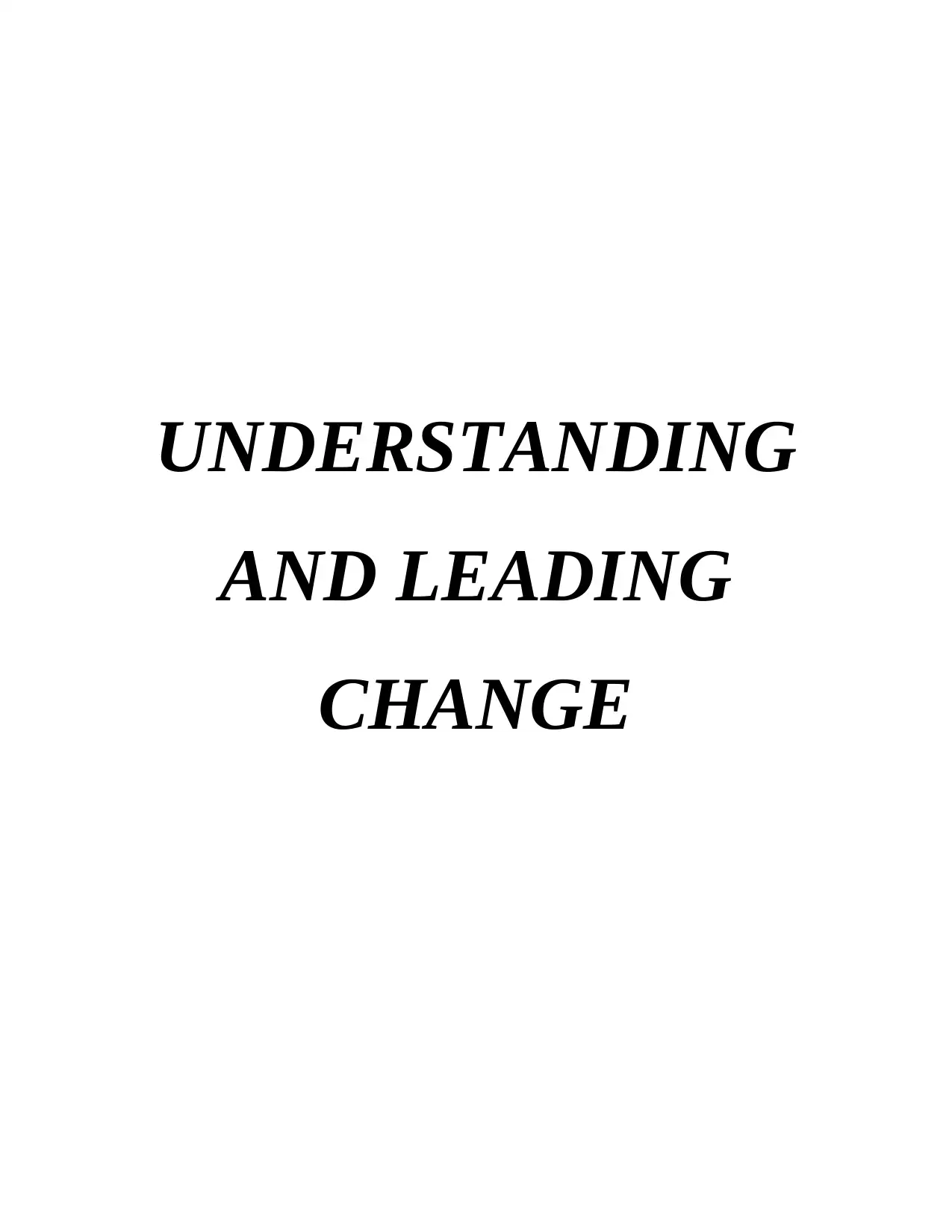
UNDERSTANDING
AND LEADING
CHANGE
AND LEADING
CHANGE
Paraphrase This Document
Need a fresh take? Get an instant paraphrase of this document with our AI Paraphraser
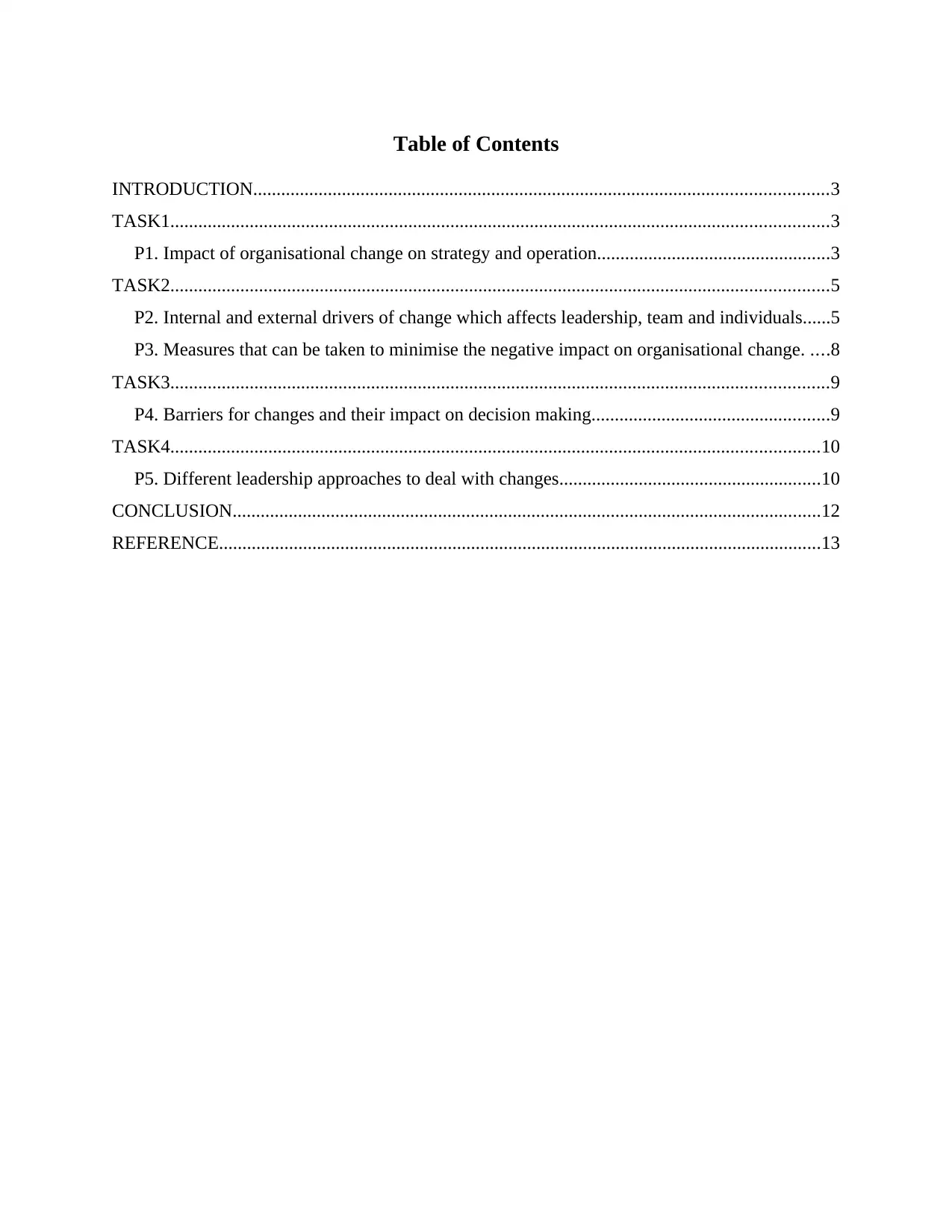
Table of Contents
INTRODUCTION...........................................................................................................................3
TASK1.............................................................................................................................................3
P1. Impact of organisational change on strategy and operation..................................................3
TASK2.............................................................................................................................................5
P2. Internal and external drivers of change which affects leadership, team and individuals......5
P3. Measures that can be taken to minimise the negative impact on organisational change. ....8
TASK3.............................................................................................................................................9
P4. Barriers for changes and their impact on decision making...................................................9
TASK4...........................................................................................................................................10
P5. Different leadership approaches to deal with changes........................................................10
CONCLUSION..............................................................................................................................12
REFERENCE.................................................................................................................................13
INTRODUCTION...........................................................................................................................3
TASK1.............................................................................................................................................3
P1. Impact of organisational change on strategy and operation..................................................3
TASK2.............................................................................................................................................5
P2. Internal and external drivers of change which affects leadership, team and individuals......5
P3. Measures that can be taken to minimise the negative impact on organisational change. ....8
TASK3.............................................................................................................................................9
P4. Barriers for changes and their impact on decision making...................................................9
TASK4...........................................................................................................................................10
P5. Different leadership approaches to deal with changes........................................................10
CONCLUSION..............................................................................................................................12
REFERENCE.................................................................................................................................13
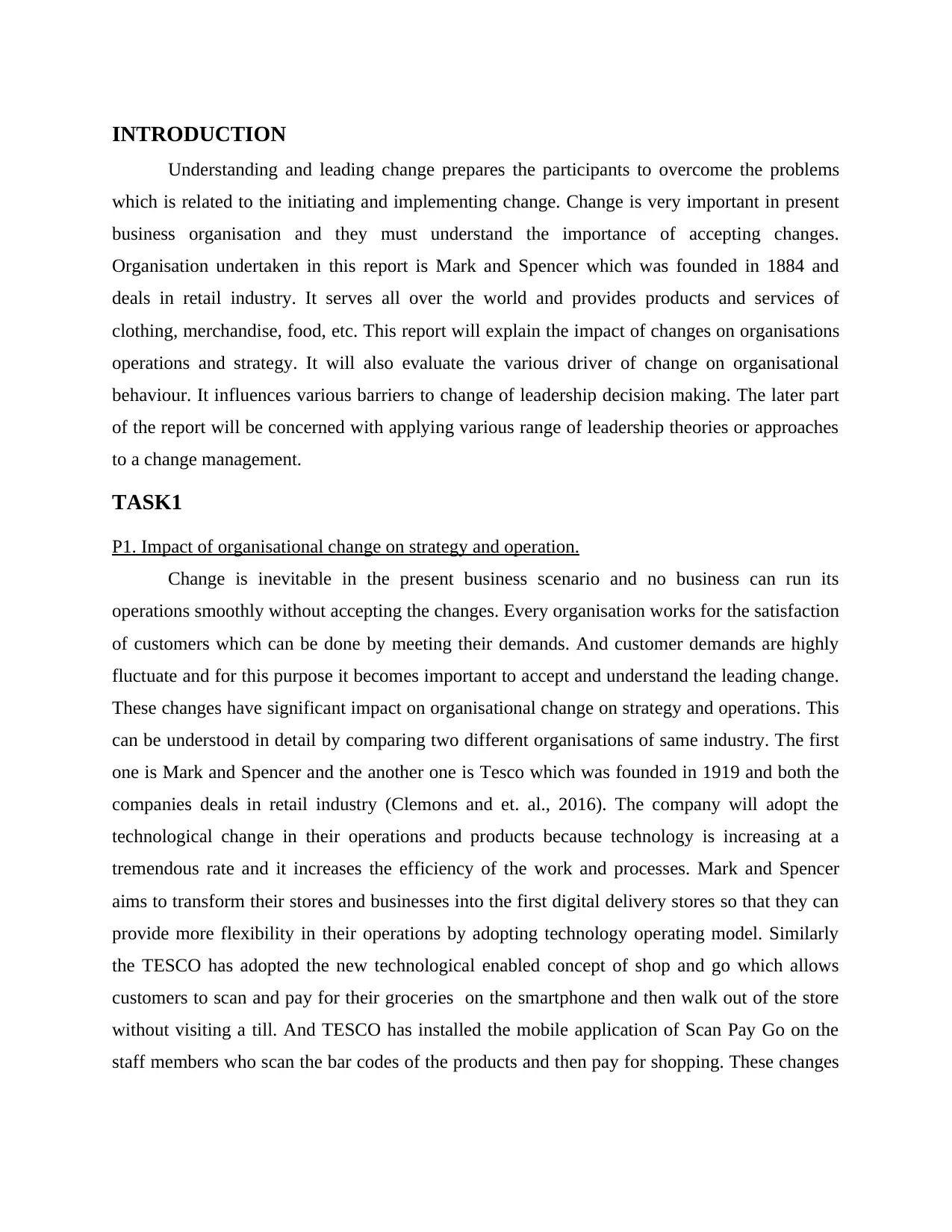
INTRODUCTION
Understanding and leading change prepares the participants to overcome the problems
which is related to the initiating and implementing change. Change is very important in present
business organisation and they must understand the importance of accepting changes.
Organisation undertaken in this report is Mark and Spencer which was founded in 1884 and
deals in retail industry. It serves all over the world and provides products and services of
clothing, merchandise, food, etc. This report will explain the impact of changes on organisations
operations and strategy. It will also evaluate the various driver of change on organisational
behaviour. It influences various barriers to change of leadership decision making. The later part
of the report will be concerned with applying various range of leadership theories or approaches
to a change management.
TASK1
P1. Impact of organisational change on strategy and operation.
Change is inevitable in the present business scenario and no business can run its
operations smoothly without accepting the changes. Every organisation works for the satisfaction
of customers which can be done by meeting their demands. And customer demands are highly
fluctuate and for this purpose it becomes important to accept and understand the leading change.
These changes have significant impact on organisational change on strategy and operations. This
can be understood in detail by comparing two different organisations of same industry. The first
one is Mark and Spencer and the another one is Tesco which was founded in 1919 and both the
companies deals in retail industry (Clemons and et. al., 2016). The company will adopt the
technological change in their operations and products because technology is increasing at a
tremendous rate and it increases the efficiency of the work and processes. Mark and Spencer
aims to transform their stores and businesses into the first digital delivery stores so that they can
provide more flexibility in their operations by adopting technology operating model. Similarly
the TESCO has adopted the new technological enabled concept of shop and go which allows
customers to scan and pay for their groceries on the smartphone and then walk out of the store
without visiting a till. And TESCO has installed the mobile application of Scan Pay Go on the
staff members who scan the bar codes of the products and then pay for shopping. These changes
Understanding and leading change prepares the participants to overcome the problems
which is related to the initiating and implementing change. Change is very important in present
business organisation and they must understand the importance of accepting changes.
Organisation undertaken in this report is Mark and Spencer which was founded in 1884 and
deals in retail industry. It serves all over the world and provides products and services of
clothing, merchandise, food, etc. This report will explain the impact of changes on organisations
operations and strategy. It will also evaluate the various driver of change on organisational
behaviour. It influences various barriers to change of leadership decision making. The later part
of the report will be concerned with applying various range of leadership theories or approaches
to a change management.
TASK1
P1. Impact of organisational change on strategy and operation.
Change is inevitable in the present business scenario and no business can run its
operations smoothly without accepting the changes. Every organisation works for the satisfaction
of customers which can be done by meeting their demands. And customer demands are highly
fluctuate and for this purpose it becomes important to accept and understand the leading change.
These changes have significant impact on organisational change on strategy and operations. This
can be understood in detail by comparing two different organisations of same industry. The first
one is Mark and Spencer and the another one is Tesco which was founded in 1919 and both the
companies deals in retail industry (Clemons and et. al., 2016). The company will adopt the
technological change in their operations and products because technology is increasing at a
tremendous rate and it increases the efficiency of the work and processes. Mark and Spencer
aims to transform their stores and businesses into the first digital delivery stores so that they can
provide more flexibility in their operations by adopting technology operating model. Similarly
the TESCO has adopted the new technological enabled concept of shop and go which allows
customers to scan and pay for their groceries on the smartphone and then walk out of the store
without visiting a till. And TESCO has installed the mobile application of Scan Pay Go on the
staff members who scan the bar codes of the products and then pay for shopping. These changes
⊘ This is a preview!⊘
Do you want full access?
Subscribe today to unlock all pages.

Trusted by 1+ million students worldwide
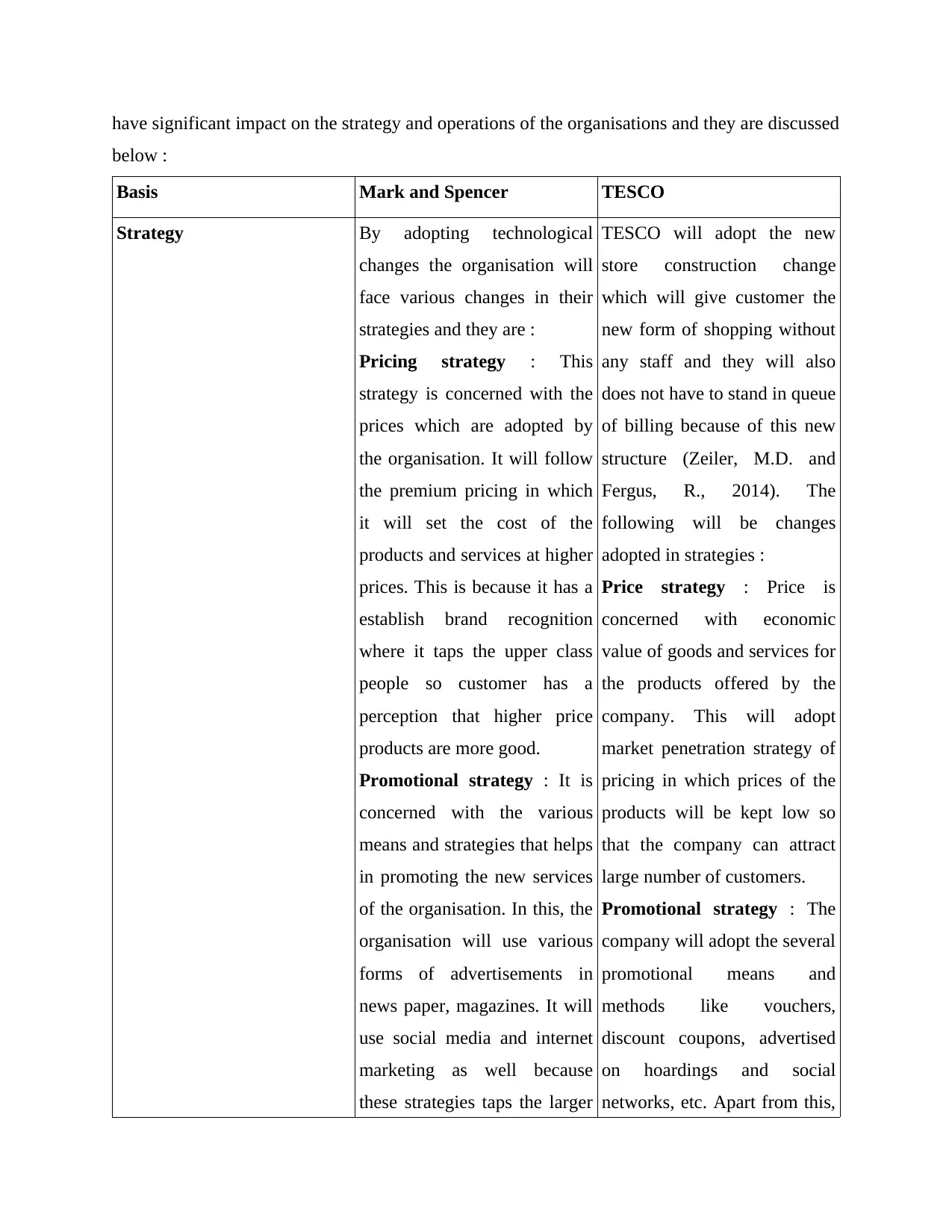
have significant impact on the strategy and operations of the organisations and they are discussed
below :
Basis Mark and Spencer TESCO
Strategy By adopting technological
changes the organisation will
face various changes in their
strategies and they are :
Pricing strategy : This
strategy is concerned with the
prices which are adopted by
the organisation. It will follow
the premium pricing in which
it will set the cost of the
products and services at higher
prices. This is because it has a
establish brand recognition
where it taps the upper class
people so customer has a
perception that higher price
products are more good.
Promotional strategy : It is
concerned with the various
means and strategies that helps
in promoting the new services
of the organisation. In this, the
organisation will use various
forms of advertisements in
news paper, magazines. It will
use social media and internet
marketing as well because
these strategies taps the larger
TESCO will adopt the new
store construction change
which will give customer the
new form of shopping without
any staff and they will also
does not have to stand in queue
of billing because of this new
structure (Zeiler, M.D. and
Fergus, R., 2014). The
following will be changes
adopted in strategies :
Price strategy : Price is
concerned with economic
value of goods and services for
the products offered by the
company. This will adopt
market penetration strategy of
pricing in which prices of the
products will be kept low so
that the company can attract
large number of customers.
Promotional strategy : The
company will adopt the several
promotional means and
methods like vouchers,
discount coupons, advertised
on hoardings and social
networks, etc. Apart from this,
below :
Basis Mark and Spencer TESCO
Strategy By adopting technological
changes the organisation will
face various changes in their
strategies and they are :
Pricing strategy : This
strategy is concerned with the
prices which are adopted by
the organisation. It will follow
the premium pricing in which
it will set the cost of the
products and services at higher
prices. This is because it has a
establish brand recognition
where it taps the upper class
people so customer has a
perception that higher price
products are more good.
Promotional strategy : It is
concerned with the various
means and strategies that helps
in promoting the new services
of the organisation. In this, the
organisation will use various
forms of advertisements in
news paper, magazines. It will
use social media and internet
marketing as well because
these strategies taps the larger
TESCO will adopt the new
store construction change
which will give customer the
new form of shopping without
any staff and they will also
does not have to stand in queue
of billing because of this new
structure (Zeiler, M.D. and
Fergus, R., 2014). The
following will be changes
adopted in strategies :
Price strategy : Price is
concerned with economic
value of goods and services for
the products offered by the
company. This will adopt
market penetration strategy of
pricing in which prices of the
products will be kept low so
that the company can attract
large number of customers.
Promotional strategy : The
company will adopt the several
promotional means and
methods like vouchers,
discount coupons, advertised
on hoardings and social
networks, etc. Apart from this,
Paraphrase This Document
Need a fresh take? Get an instant paraphrase of this document with our AI Paraphraser
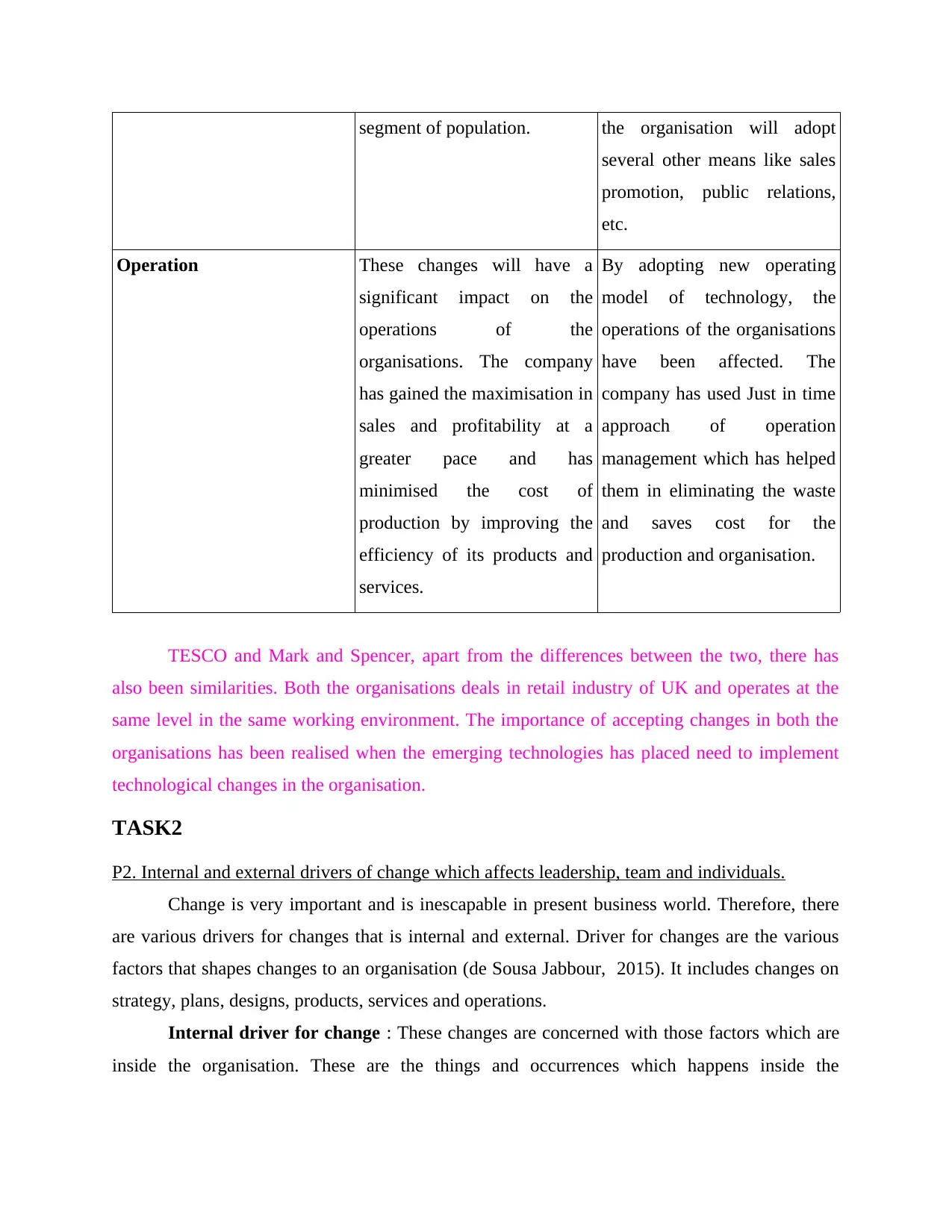
segment of population. the organisation will adopt
several other means like sales
promotion, public relations,
etc.
Operation These changes will have a
significant impact on the
operations of the
organisations. The company
has gained the maximisation in
sales and profitability at a
greater pace and has
minimised the cost of
production by improving the
efficiency of its products and
services.
By adopting new operating
model of technology, the
operations of the organisations
have been affected. The
company has used Just in time
approach of operation
management which has helped
them in eliminating the waste
and saves cost for the
production and organisation.
TESCO and Mark and Spencer, apart from the differences between the two, there has
also been similarities. Both the organisations deals in retail industry of UK and operates at the
same level in the same working environment. The importance of accepting changes in both the
organisations has been realised when the emerging technologies has placed need to implement
technological changes in the organisation.
TASK2
P2. Internal and external drivers of change which affects leadership, team and individuals.
Change is very important and is inescapable in present business world. Therefore, there
are various drivers for changes that is internal and external. Driver for changes are the various
factors that shapes changes to an organisation (de Sousa Jabbour, 2015). It includes changes on
strategy, plans, designs, products, services and operations.
Internal driver for change : These changes are concerned with those factors which are
inside the organisation. These are the things and occurrences which happens inside the
several other means like sales
promotion, public relations,
etc.
Operation These changes will have a
significant impact on the
operations of the
organisations. The company
has gained the maximisation in
sales and profitability at a
greater pace and has
minimised the cost of
production by improving the
efficiency of its products and
services.
By adopting new operating
model of technology, the
operations of the organisations
have been affected. The
company has used Just in time
approach of operation
management which has helped
them in eliminating the waste
and saves cost for the
production and organisation.
TESCO and Mark and Spencer, apart from the differences between the two, there has
also been similarities. Both the organisations deals in retail industry of UK and operates at the
same level in the same working environment. The importance of accepting changes in both the
organisations has been realised when the emerging technologies has placed need to implement
technological changes in the organisation.
TASK2
P2. Internal and external drivers of change which affects leadership, team and individuals.
Change is very important and is inescapable in present business world. Therefore, there
are various drivers for changes that is internal and external. Driver for changes are the various
factors that shapes changes to an organisation (de Sousa Jabbour, 2015). It includes changes on
strategy, plans, designs, products, services and operations.
Internal driver for change : These changes are concerned with those factors which are
inside the organisation. These are the things and occurrences which happens inside the
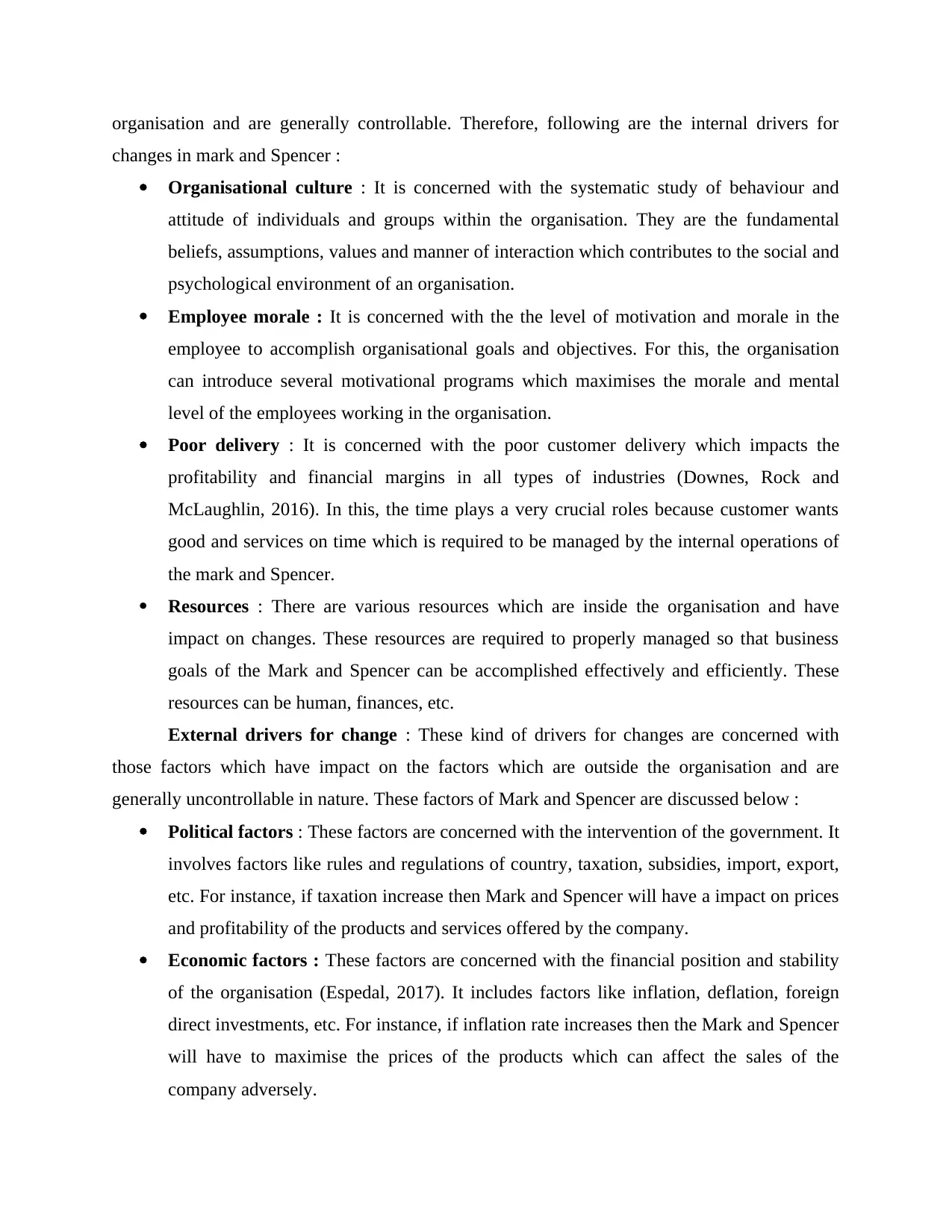
organisation and are generally controllable. Therefore, following are the internal drivers for
changes in mark and Spencer :
Organisational culture : It is concerned with the systematic study of behaviour and
attitude of individuals and groups within the organisation. They are the fundamental
beliefs, assumptions, values and manner of interaction which contributes to the social and
psychological environment of an organisation.
Employee morale : It is concerned with the the level of motivation and morale in the
employee to accomplish organisational goals and objectives. For this, the organisation
can introduce several motivational programs which maximises the morale and mental
level of the employees working in the organisation.
Poor delivery : It is concerned with the poor customer delivery which impacts the
profitability and financial margins in all types of industries (Downes, Rock and
McLaughlin, 2016). In this, the time plays a very crucial roles because customer wants
good and services on time which is required to be managed by the internal operations of
the mark and Spencer.
Resources : There are various resources which are inside the organisation and have
impact on changes. These resources are required to properly managed so that business
goals of the Mark and Spencer can be accomplished effectively and efficiently. These
resources can be human, finances, etc.
External drivers for change : These kind of drivers for changes are concerned with
those factors which have impact on the factors which are outside the organisation and are
generally uncontrollable in nature. These factors of Mark and Spencer are discussed below :
Political factors : These factors are concerned with the intervention of the government. It
involves factors like rules and regulations of country, taxation, subsidies, import, export,
etc. For instance, if taxation increase then Mark and Spencer will have a impact on prices
and profitability of the products and services offered by the company.
Economic factors : These factors are concerned with the financial position and stability
of the organisation (Espedal, 2017). It includes factors like inflation, deflation, foreign
direct investments, etc. For instance, if inflation rate increases then the Mark and Spencer
will have to maximise the prices of the products which can affect the sales of the
company adversely.
changes in mark and Spencer :
Organisational culture : It is concerned with the systematic study of behaviour and
attitude of individuals and groups within the organisation. They are the fundamental
beliefs, assumptions, values and manner of interaction which contributes to the social and
psychological environment of an organisation.
Employee morale : It is concerned with the the level of motivation and morale in the
employee to accomplish organisational goals and objectives. For this, the organisation
can introduce several motivational programs which maximises the morale and mental
level of the employees working in the organisation.
Poor delivery : It is concerned with the poor customer delivery which impacts the
profitability and financial margins in all types of industries (Downes, Rock and
McLaughlin, 2016). In this, the time plays a very crucial roles because customer wants
good and services on time which is required to be managed by the internal operations of
the mark and Spencer.
Resources : There are various resources which are inside the organisation and have
impact on changes. These resources are required to properly managed so that business
goals of the Mark and Spencer can be accomplished effectively and efficiently. These
resources can be human, finances, etc.
External drivers for change : These kind of drivers for changes are concerned with
those factors which have impact on the factors which are outside the organisation and are
generally uncontrollable in nature. These factors of Mark and Spencer are discussed below :
Political factors : These factors are concerned with the intervention of the government. It
involves factors like rules and regulations of country, taxation, subsidies, import, export,
etc. For instance, if taxation increase then Mark and Spencer will have a impact on prices
and profitability of the products and services offered by the company.
Economic factors : These factors are concerned with the financial position and stability
of the organisation (Espedal, 2017). It includes factors like inflation, deflation, foreign
direct investments, etc. For instance, if inflation rate increases then the Mark and Spencer
will have to maximise the prices of the products which can affect the sales of the
company adversely.
⊘ This is a preview!⊘
Do you want full access?
Subscribe today to unlock all pages.

Trusted by 1+ million students worldwide
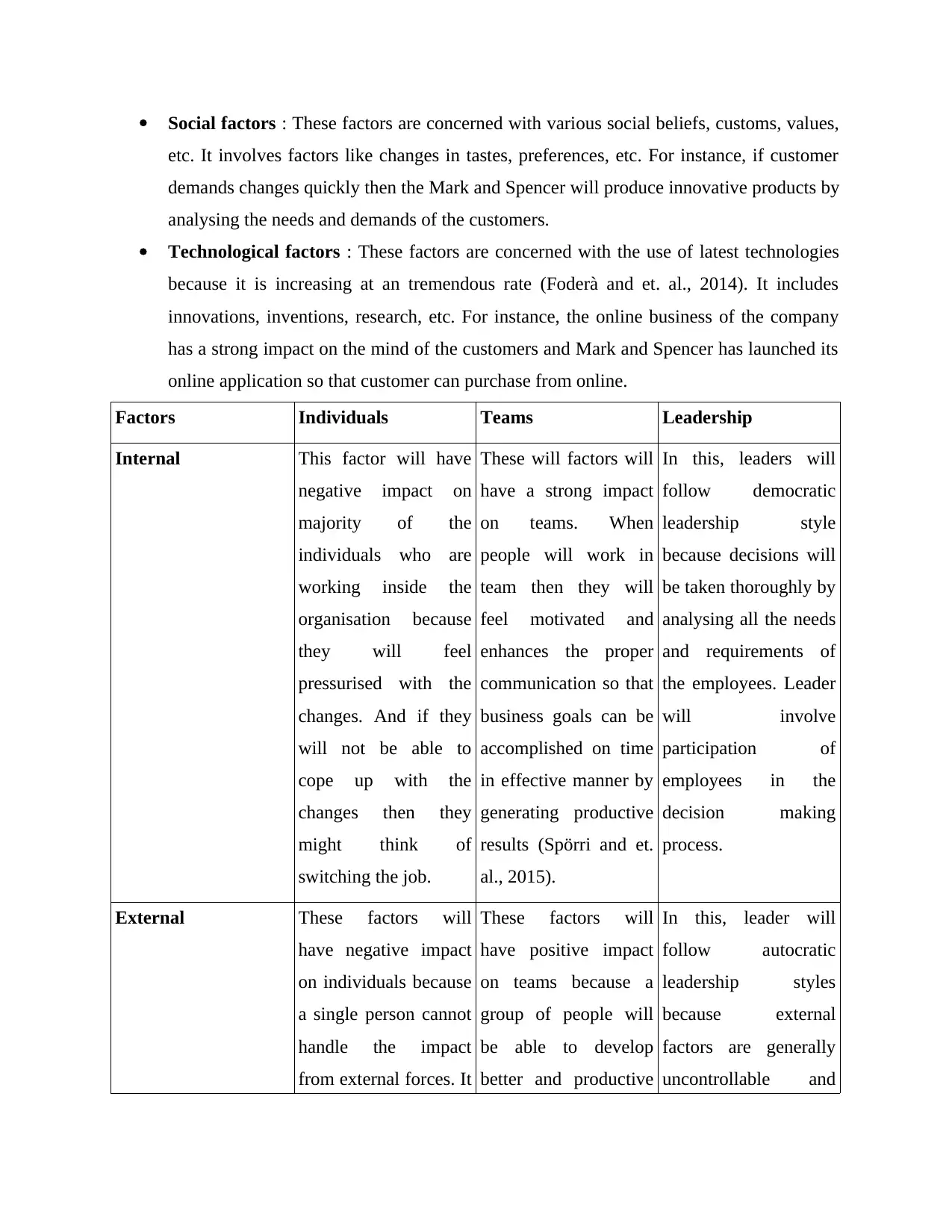
Social factors : These factors are concerned with various social beliefs, customs, values,
etc. It involves factors like changes in tastes, preferences, etc. For instance, if customer
demands changes quickly then the Mark and Spencer will produce innovative products by
analysing the needs and demands of the customers.
Technological factors : These factors are concerned with the use of latest technologies
because it is increasing at an tremendous rate (Foderà and et. al., 2014). It includes
innovations, inventions, research, etc. For instance, the online business of the company
has a strong impact on the mind of the customers and Mark and Spencer has launched its
online application so that customer can purchase from online.
Factors Individuals Teams Leadership
Internal This factor will have
negative impact on
majority of the
individuals who are
working inside the
organisation because
they will feel
pressurised with the
changes. And if they
will not be able to
cope up with the
changes then they
might think of
switching the job.
These will factors will
have a strong impact
on teams. When
people will work in
team then they will
feel motivated and
enhances the proper
communication so that
business goals can be
accomplished on time
in effective manner by
generating productive
results (Spörri and et.
al., 2015).
In this, leaders will
follow democratic
leadership style
because decisions will
be taken thoroughly by
analysing all the needs
and requirements of
the employees. Leader
will involve
participation of
employees in the
decision making
process.
External These factors will
have negative impact
on individuals because
a single person cannot
handle the impact
from external forces. It
These factors will
have positive impact
on teams because a
group of people will
be able to develop
better and productive
In this, leader will
follow autocratic
leadership styles
because external
factors are generally
uncontrollable and
etc. It involves factors like changes in tastes, preferences, etc. For instance, if customer
demands changes quickly then the Mark and Spencer will produce innovative products by
analysing the needs and demands of the customers.
Technological factors : These factors are concerned with the use of latest technologies
because it is increasing at an tremendous rate (Foderà and et. al., 2014). It includes
innovations, inventions, research, etc. For instance, the online business of the company
has a strong impact on the mind of the customers and Mark and Spencer has launched its
online application so that customer can purchase from online.
Factors Individuals Teams Leadership
Internal This factor will have
negative impact on
majority of the
individuals who are
working inside the
organisation because
they will feel
pressurised with the
changes. And if they
will not be able to
cope up with the
changes then they
might think of
switching the job.
These will factors will
have a strong impact
on teams. When
people will work in
team then they will
feel motivated and
enhances the proper
communication so that
business goals can be
accomplished on time
in effective manner by
generating productive
results (Spörri and et.
al., 2015).
In this, leaders will
follow democratic
leadership style
because decisions will
be taken thoroughly by
analysing all the needs
and requirements of
the employees. Leader
will involve
participation of
employees in the
decision making
process.
External These factors will
have negative impact
on individuals because
a single person cannot
handle the impact
from external forces. It
These factors will
have positive impact
on teams because a
group of people will
be able to develop
better and productive
In this, leader will
follow autocratic
leadership styles
because external
factors are generally
uncontrollable and
Paraphrase This Document
Need a fresh take? Get an instant paraphrase of this document with our AI Paraphraser
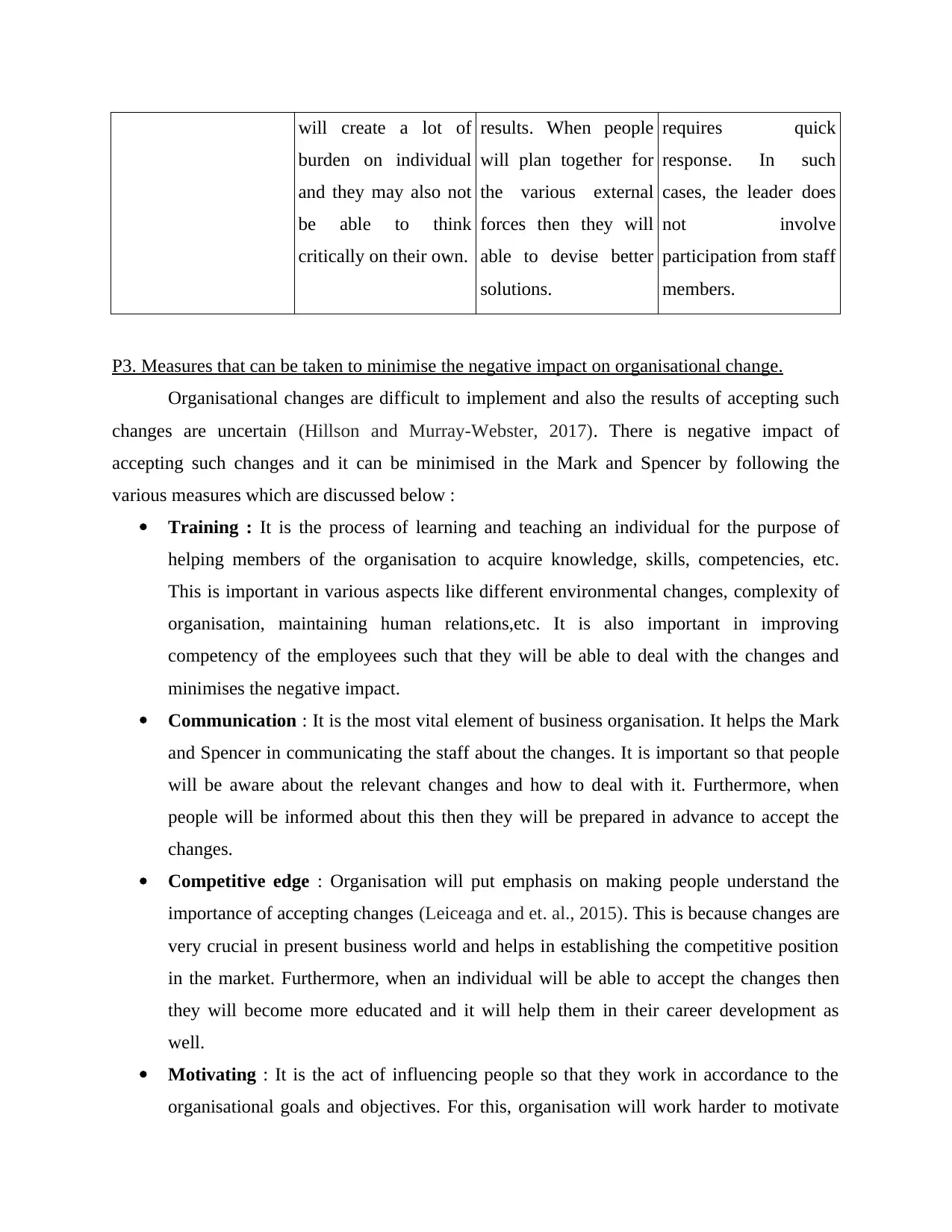
will create a lot of
burden on individual
and they may also not
be able to think
critically on their own.
results. When people
will plan together for
the various external
forces then they will
able to devise better
solutions.
requires quick
response. In such
cases, the leader does
not involve
participation from staff
members.
P3. Measures that can be taken to minimise the negative impact on organisational change.
Organisational changes are difficult to implement and also the results of accepting such
changes are uncertain (Hillson and Murray-Webster, 2017). There is negative impact of
accepting such changes and it can be minimised in the Mark and Spencer by following the
various measures which are discussed below :
Training : It is the process of learning and teaching an individual for the purpose of
helping members of the organisation to acquire knowledge, skills, competencies, etc.
This is important in various aspects like different environmental changes, complexity of
organisation, maintaining human relations,etc. It is also important in improving
competency of the employees such that they will be able to deal with the changes and
minimises the negative impact.
Communication : It is the most vital element of business organisation. It helps the Mark
and Spencer in communicating the staff about the changes. It is important so that people
will be aware about the relevant changes and how to deal with it. Furthermore, when
people will be informed about this then they will be prepared in advance to accept the
changes.
Competitive edge : Organisation will put emphasis on making people understand the
importance of accepting changes (Leiceaga and et. al., 2015). This is because changes are
very crucial in present business world and helps in establishing the competitive position
in the market. Furthermore, when an individual will be able to accept the changes then
they will become more educated and it will help them in their career development as
well.
Motivating : It is the act of influencing people so that they work in accordance to the
organisational goals and objectives. For this, organisation will work harder to motivate
burden on individual
and they may also not
be able to think
critically on their own.
results. When people
will plan together for
the various external
forces then they will
able to devise better
solutions.
requires quick
response. In such
cases, the leader does
not involve
participation from staff
members.
P3. Measures that can be taken to minimise the negative impact on organisational change.
Organisational changes are difficult to implement and also the results of accepting such
changes are uncertain (Hillson and Murray-Webster, 2017). There is negative impact of
accepting such changes and it can be minimised in the Mark and Spencer by following the
various measures which are discussed below :
Training : It is the process of learning and teaching an individual for the purpose of
helping members of the organisation to acquire knowledge, skills, competencies, etc.
This is important in various aspects like different environmental changes, complexity of
organisation, maintaining human relations,etc. It is also important in improving
competency of the employees such that they will be able to deal with the changes and
minimises the negative impact.
Communication : It is the most vital element of business organisation. It helps the Mark
and Spencer in communicating the staff about the changes. It is important so that people
will be aware about the relevant changes and how to deal with it. Furthermore, when
people will be informed about this then they will be prepared in advance to accept the
changes.
Competitive edge : Organisation will put emphasis on making people understand the
importance of accepting changes (Leiceaga and et. al., 2015). This is because changes are
very crucial in present business world and helps in establishing the competitive position
in the market. Furthermore, when an individual will be able to accept the changes then
they will become more educated and it will help them in their career development as
well.
Motivating : It is the act of influencing people so that they work in accordance to the
organisational goals and objectives. For this, organisation will work harder to motivate
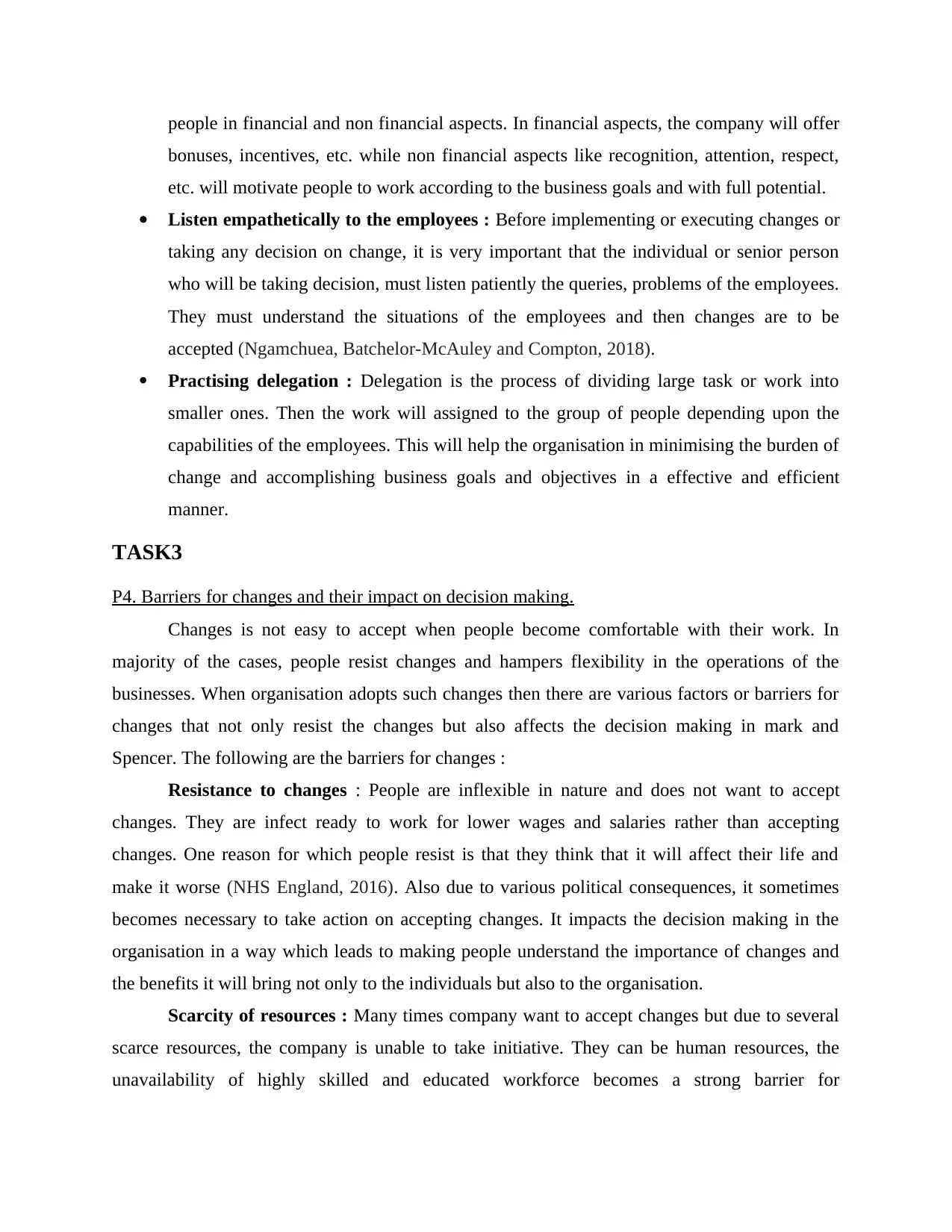
people in financial and non financial aspects. In financial aspects, the company will offer
bonuses, incentives, etc. while non financial aspects like recognition, attention, respect,
etc. will motivate people to work according to the business goals and with full potential.
Listen empathetically to the employees : Before implementing or executing changes or
taking any decision on change, it is very important that the individual or senior person
who will be taking decision, must listen patiently the queries, problems of the employees.
They must understand the situations of the employees and then changes are to be
accepted (Ngamchuea, Batchelor-McAuley and Compton, 2018).
Practising delegation : Delegation is the process of dividing large task or work into
smaller ones. Then the work will assigned to the group of people depending upon the
capabilities of the employees. This will help the organisation in minimising the burden of
change and accomplishing business goals and objectives in a effective and efficient
manner.
TASK3
P4. Barriers for changes and their impact on decision making.
Changes is not easy to accept when people become comfortable with their work. In
majority of the cases, people resist changes and hampers flexibility in the operations of the
businesses. When organisation adopts such changes then there are various factors or barriers for
changes that not only resist the changes but also affects the decision making in mark and
Spencer. The following are the barriers for changes :
Resistance to changes : People are inflexible in nature and does not want to accept
changes. They are infect ready to work for lower wages and salaries rather than accepting
changes. One reason for which people resist is that they think that it will affect their life and
make it worse (NHS England, 2016). Also due to various political consequences, it sometimes
becomes necessary to take action on accepting changes. It impacts the decision making in the
organisation in a way which leads to making people understand the importance of changes and
the benefits it will bring not only to the individuals but also to the organisation.
Scarcity of resources : Many times company want to accept changes but due to several
scarce resources, the company is unable to take initiative. They can be human resources, the
unavailability of highly skilled and educated workforce becomes a strong barrier for
bonuses, incentives, etc. while non financial aspects like recognition, attention, respect,
etc. will motivate people to work according to the business goals and with full potential.
Listen empathetically to the employees : Before implementing or executing changes or
taking any decision on change, it is very important that the individual or senior person
who will be taking decision, must listen patiently the queries, problems of the employees.
They must understand the situations of the employees and then changes are to be
accepted (Ngamchuea, Batchelor-McAuley and Compton, 2018).
Practising delegation : Delegation is the process of dividing large task or work into
smaller ones. Then the work will assigned to the group of people depending upon the
capabilities of the employees. This will help the organisation in minimising the burden of
change and accomplishing business goals and objectives in a effective and efficient
manner.
TASK3
P4. Barriers for changes and their impact on decision making.
Changes is not easy to accept when people become comfortable with their work. In
majority of the cases, people resist changes and hampers flexibility in the operations of the
businesses. When organisation adopts such changes then there are various factors or barriers for
changes that not only resist the changes but also affects the decision making in mark and
Spencer. The following are the barriers for changes :
Resistance to changes : People are inflexible in nature and does not want to accept
changes. They are infect ready to work for lower wages and salaries rather than accepting
changes. One reason for which people resist is that they think that it will affect their life and
make it worse (NHS England, 2016). Also due to various political consequences, it sometimes
becomes necessary to take action on accepting changes. It impacts the decision making in the
organisation in a way which leads to making people understand the importance of changes and
the benefits it will bring not only to the individuals but also to the organisation.
Scarcity of resources : Many times company want to accept changes but due to several
scarce resources, the company is unable to take initiative. They can be human resources, the
unavailability of highly skilled and educated workforce becomes a strong barrier for
⊘ This is a preview!⊘
Do you want full access?
Subscribe today to unlock all pages.

Trusted by 1+ million students worldwide
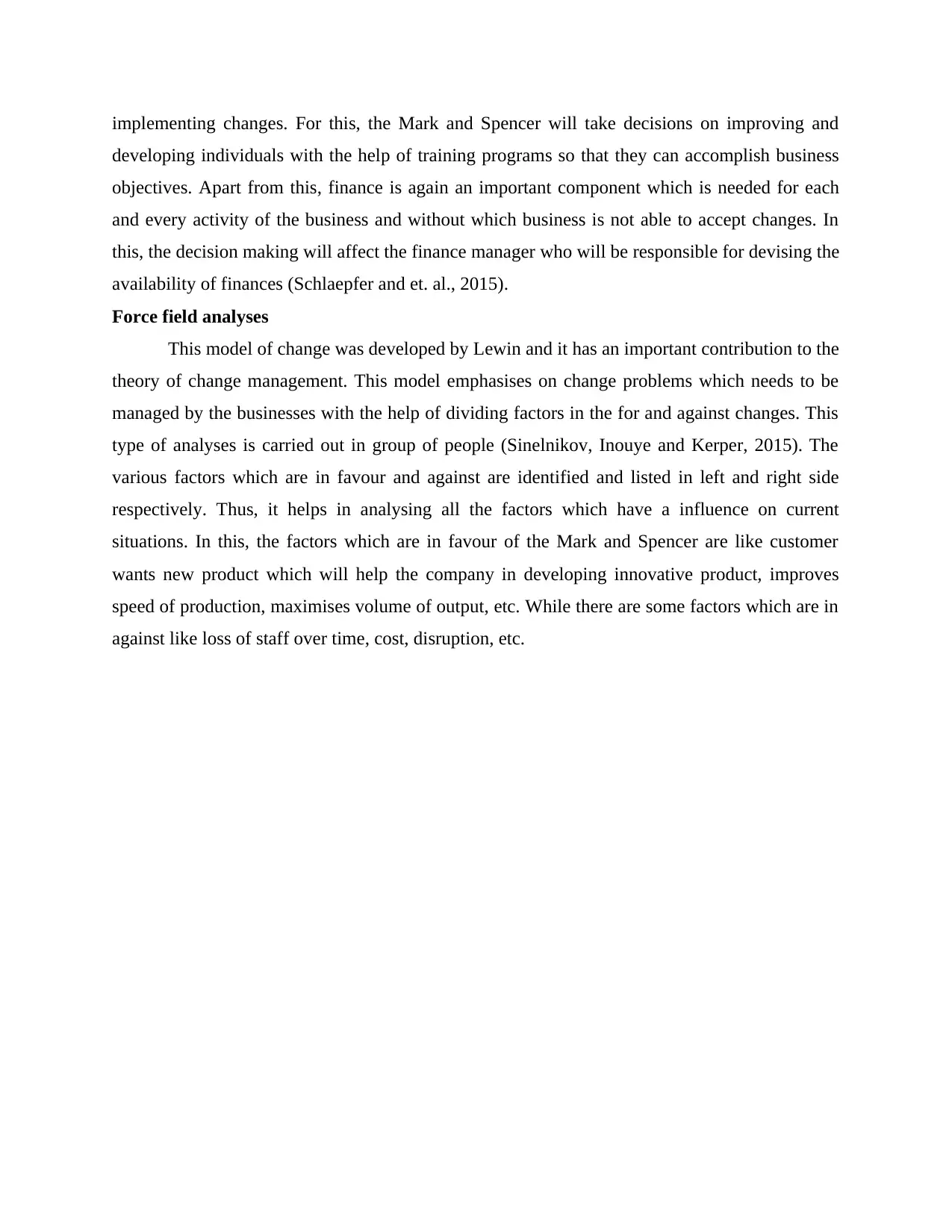
implementing changes. For this, the Mark and Spencer will take decisions on improving and
developing individuals with the help of training programs so that they can accomplish business
objectives. Apart from this, finance is again an important component which is needed for each
and every activity of the business and without which business is not able to accept changes. In
this, the decision making will affect the finance manager who will be responsible for devising the
availability of finances (Schlaepfer and et. al., 2015).
Force field analyses
This model of change was developed by Lewin and it has an important contribution to the
theory of change management. This model emphasises on change problems which needs to be
managed by the businesses with the help of dividing factors in the for and against changes. This
type of analyses is carried out in group of people (Sinelnikov, Inouye and Kerper, 2015). The
various factors which are in favour and against are identified and listed in left and right side
respectively. Thus, it helps in analysing all the factors which have a influence on current
situations. In this, the factors which are in favour of the Mark and Spencer are like customer
wants new product which will help the company in developing innovative product, improves
speed of production, maximises volume of output, etc. While there are some factors which are in
against like loss of staff over time, cost, disruption, etc.
developing individuals with the help of training programs so that they can accomplish business
objectives. Apart from this, finance is again an important component which is needed for each
and every activity of the business and without which business is not able to accept changes. In
this, the decision making will affect the finance manager who will be responsible for devising the
availability of finances (Schlaepfer and et. al., 2015).
Force field analyses
This model of change was developed by Lewin and it has an important contribution to the
theory of change management. This model emphasises on change problems which needs to be
managed by the businesses with the help of dividing factors in the for and against changes. This
type of analyses is carried out in group of people (Sinelnikov, Inouye and Kerper, 2015). The
various factors which are in favour and against are identified and listed in left and right side
respectively. Thus, it helps in analysing all the factors which have a influence on current
situations. In this, the factors which are in favour of the Mark and Spencer are like customer
wants new product which will help the company in developing innovative product, improves
speed of production, maximises volume of output, etc. While there are some factors which are in
against like loss of staff over time, cost, disruption, etc.
Paraphrase This Document
Need a fresh take? Get an instant paraphrase of this document with our AI Paraphraser
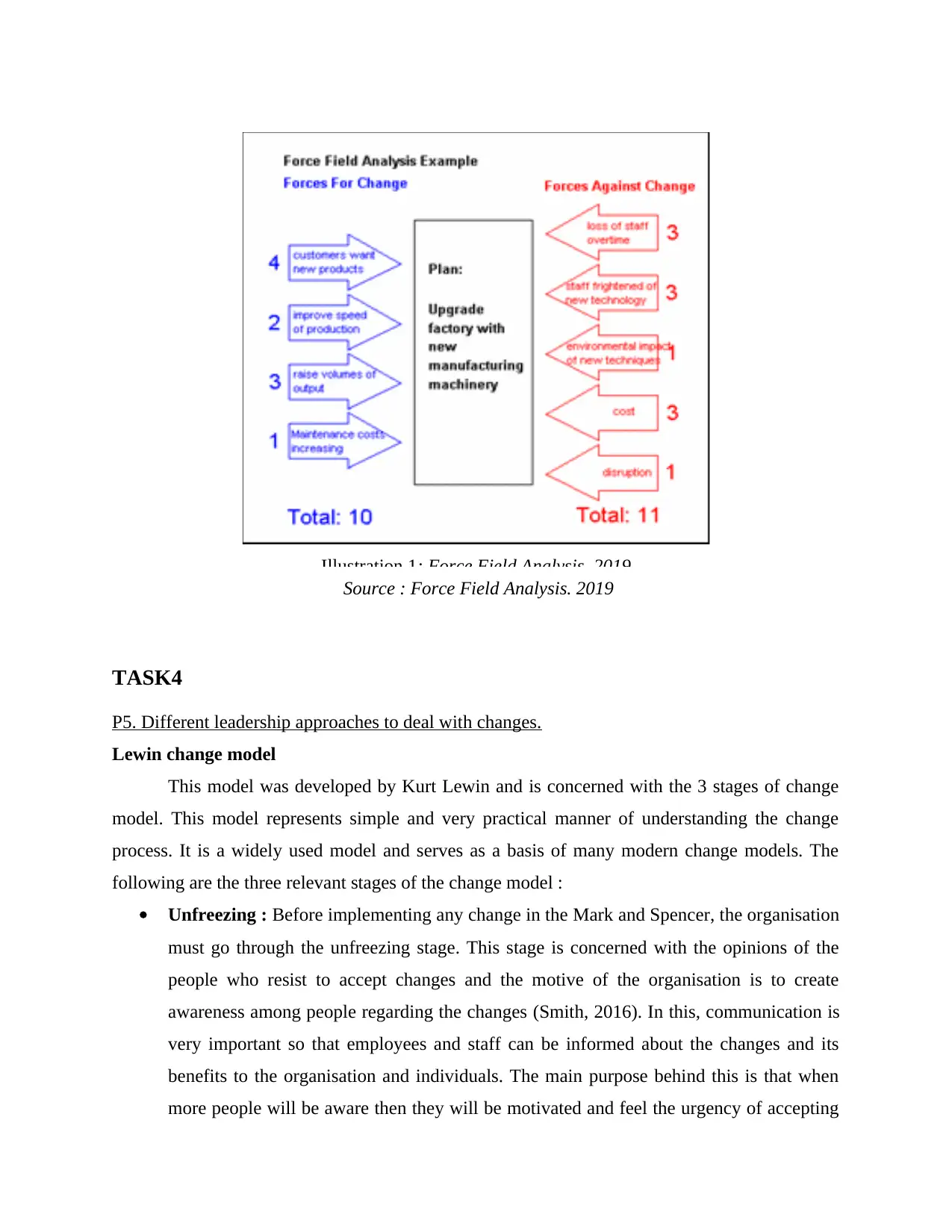
Source : Force Field Analysis. 2019
TASK4
P5. Different leadership approaches to deal with changes.
Lewin change model
This model was developed by Kurt Lewin and is concerned with the 3 stages of change
model. This model represents simple and very practical manner of understanding the change
process. It is a widely used model and serves as a basis of many modern change models. The
following are the three relevant stages of the change model :
Unfreezing : Before implementing any change in the Mark and Spencer, the organisation
must go through the unfreezing stage. This stage is concerned with the opinions of the
people who resist to accept changes and the motive of the organisation is to create
awareness among people regarding the changes (Smith, 2016). In this, communication is
very important so that employees and staff can be informed about the changes and its
benefits to the organisation and individuals. The main purpose behind this is that when
more people will be aware then they will be motivated and feel the urgency of accepting
Illustration 1: Force Field Analysis. 2019
TASK4
P5. Different leadership approaches to deal with changes.
Lewin change model
This model was developed by Kurt Lewin and is concerned with the 3 stages of change
model. This model represents simple and very practical manner of understanding the change
process. It is a widely used model and serves as a basis of many modern change models. The
following are the three relevant stages of the change model :
Unfreezing : Before implementing any change in the Mark and Spencer, the organisation
must go through the unfreezing stage. This stage is concerned with the opinions of the
people who resist to accept changes and the motive of the organisation is to create
awareness among people regarding the changes (Smith, 2016). In this, communication is
very important so that employees and staff can be informed about the changes and its
benefits to the organisation and individuals. The main purpose behind this is that when
more people will be aware then they will be motivated and feel the urgency of accepting
Illustration 1: Force Field Analysis. 2019
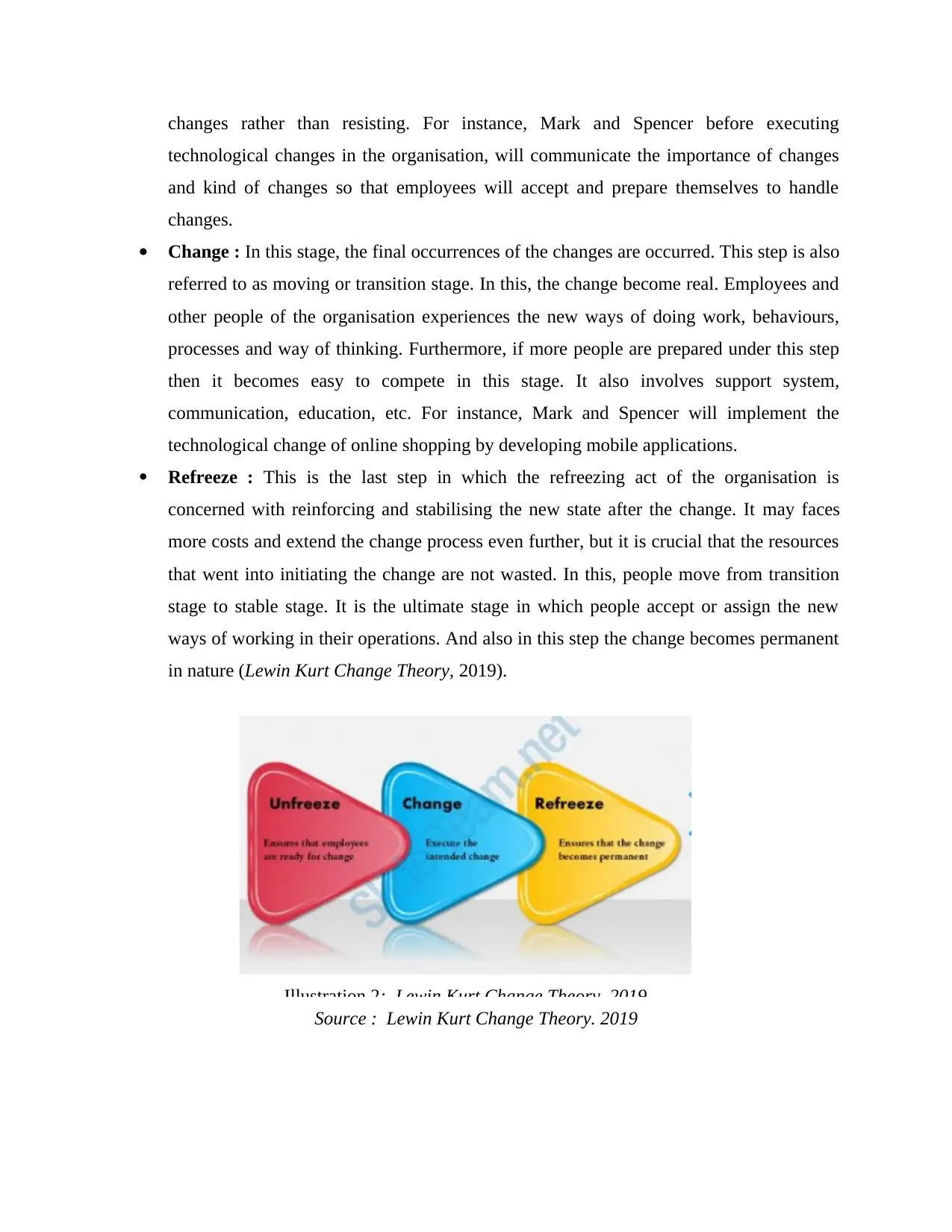
changes rather than resisting. For instance, Mark and Spencer before executing
technological changes in the organisation, will communicate the importance of changes
and kind of changes so that employees will accept and prepare themselves to handle
changes.
Change : In this stage, the final occurrences of the changes are occurred. This step is also
referred to as moving or transition stage. In this, the change become real. Employees and
other people of the organisation experiences the new ways of doing work, behaviours,
processes and way of thinking. Furthermore, if more people are prepared under this step
then it becomes easy to compete in this stage. It also involves support system,
communication, education, etc. For instance, Mark and Spencer will implement the
technological change of online shopping by developing mobile applications.
Refreeze : This is the last step in which the refreezing act of the organisation is
concerned with reinforcing and stabilising the new state after the change. It may faces
more costs and extend the change process even further, but it is crucial that the resources
that went into initiating the change are not wasted. In this, people move from transition
stage to stable stage. It is the ultimate stage in which people accept or assign the new
ways of working in their operations. And also in this step the change becomes permanent
in nature (Lewin Kurt Change Theory, 2019).
Source : Lewin Kurt Change Theory. 2019
Illustration 2: Lewin Kurt Change Theory. 2019
technological changes in the organisation, will communicate the importance of changes
and kind of changes so that employees will accept and prepare themselves to handle
changes.
Change : In this stage, the final occurrences of the changes are occurred. This step is also
referred to as moving or transition stage. In this, the change become real. Employees and
other people of the organisation experiences the new ways of doing work, behaviours,
processes and way of thinking. Furthermore, if more people are prepared under this step
then it becomes easy to compete in this stage. It also involves support system,
communication, education, etc. For instance, Mark and Spencer will implement the
technological change of online shopping by developing mobile applications.
Refreeze : This is the last step in which the refreezing act of the organisation is
concerned with reinforcing and stabilising the new state after the change. It may faces
more costs and extend the change process even further, but it is crucial that the resources
that went into initiating the change are not wasted. In this, people move from transition
stage to stable stage. It is the ultimate stage in which people accept or assign the new
ways of working in their operations. And also in this step the change becomes permanent
in nature (Lewin Kurt Change Theory, 2019).
Source : Lewin Kurt Change Theory. 2019
Illustration 2: Lewin Kurt Change Theory. 2019
⊘ This is a preview!⊘
Do you want full access?
Subscribe today to unlock all pages.

Trusted by 1+ million students worldwide
1 out of 14
Related Documents
Your All-in-One AI-Powered Toolkit for Academic Success.
+13062052269
info@desklib.com
Available 24*7 on WhatsApp / Email
![[object Object]](/_next/static/media/star-bottom.7253800d.svg)
Unlock your academic potential
Copyright © 2020–2025 A2Z Services. All Rights Reserved. Developed and managed by ZUCOL.





